The Blind Photographer
by Dr. Wayne Lynch

I sat in my first photo blind nearly 40 years ago. I remember my excitement as if it happened only yesterday. I had made the blind from green burlap supported by aluminum poles and set it up in shallow water about 30 meters from a nesting common loon. When the bird climbed atop its shoreline nest my heart was pounding so loudly I was certain the noise would frighten the loon away. In the decades since then I have used blinds as often as I could. I’ve enjoyed the same level of exhilaration while secretly watching babbling waterfowl, nesting owls, preening eagles, warbling songbirds, cavorting red fox pups, burrowing badgers, sun-bathing crocodiles, muskoxen, seals and bears to name just a few.

For me the photo blind is the most valuable piece of equipment I use to capture candid and captivating photographs of wildlife. Here are four tips to get you started: what, where, why and when?
What Is a Photo Blind?
A photo blind is anything that masks or hides your outline. It can be as simple as a canvas sac that you toss over yourself and your camera gear (Google Rue Pocket Blind or Kirk N-visi Blind) to an elaborate enclosure made of chicken wire and woven with cattails, bulrushes or branches. I’ve also had success using a simple cardboard box used for shipping large household appliances such as washers, dryers and kitchen stoves. Most often I use a homemade rectangular tent-like blind (1 meter x1 meter x 1.5 meter tall) made of heavy camouflage fabric or canvas with camera ports on all four sides and supported by aluminum poles in the corners held upright with cord that is secured to tent pegs. Commercial blinds are available on the internet and sell for $300-$500.

Dr. Wayne Lynch sitting inside a Pocket Blind
Once I’m inside the blind I try to make myself as comfortable as possible so I generally park my butt on a comfortable lawn chair and I bring along water and snacks. The more comfortable you are the greater your patience will be, and the more likely you are to persevere through a long wait which often yields the greatest rewards. I’ve spent as long as seven hours at a stretch hidden inside a blind to get photographs of a nesting burrowing owl. Accept the fact that to be a successful blind photographer you need to be a patient voyeur.
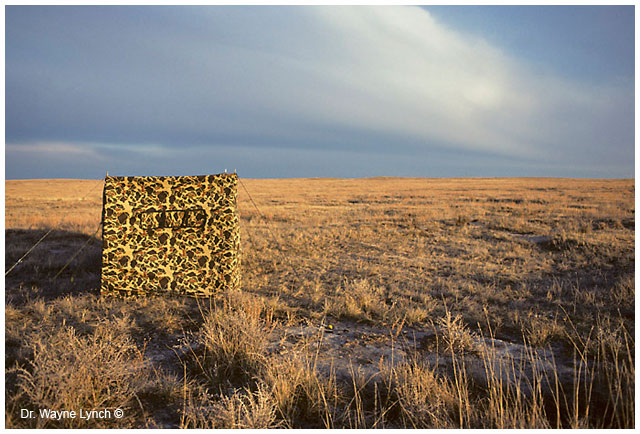
Dr. Wayne Lynch's photo blind for photographing birds on the prairies
Where Should You Locate A Blind?
Here are three great locations where I have found a photo blind to be especially effective:
- Game trails
- Bird nests & animal dens
- Waterfowl & shorebird feeding and loafing areas

Red Fox
All of the above locations offer predictable wildlife activity, although they definitely vary from place to place and from season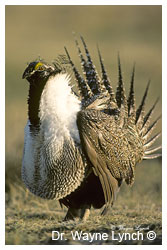 to season. Before I set up a blind I always scout the location beforehand to see how promising the site looks, how skittish the wildlife is, and whether my blind is likely to cause a disturbance. In these times of increasing human population and declining wilderness no photographer should place the pursuit of an image ahead of the welfare of the environment or the survival or well-being of a wild creature. For example, if your blind causes undue delay in the return of an incubating bird to its nest or alerts a predator or a mischievous human to the location of a nest or den then you should remove the blind immediately and search for safer location. to season. Before I set up a blind I always scout the location beforehand to see how promising the site looks, how skittish the wildlife is, and whether my blind is likely to cause a disturbance. In these times of increasing human population and declining wilderness no photographer should place the pursuit of an image ahead of the welfare of the environment or the survival or well-being of a wild creature. For example, if your blind causes undue delay in the return of an incubating bird to its nest or alerts a predator or a mischievous human to the location of a nest or den then you should remove the blind immediately and search for safer location.
Blinds are not only a wonderful way to hide from wildlife on land, they can also be used effectively in the water and in the tops of trees. Hiding your blind in the water among cattails and bulrushes can get you eye-level views of ducks, geese, grebes, pelicans, and shorebirds, not to mention courting muskrats, water-logged beavers and playful river otters. Treetop photography takes more preparation and care. You can erect free-standing towers (I’ve used some as tall as 15 meters) or modify a conventional tree stand used by hunters and surround yourself with a screen of fabric. Just remember, when a photographer falls out of a tree he/she generally hits the ground with a boom, very little bounce, and a whole lot of ouch.
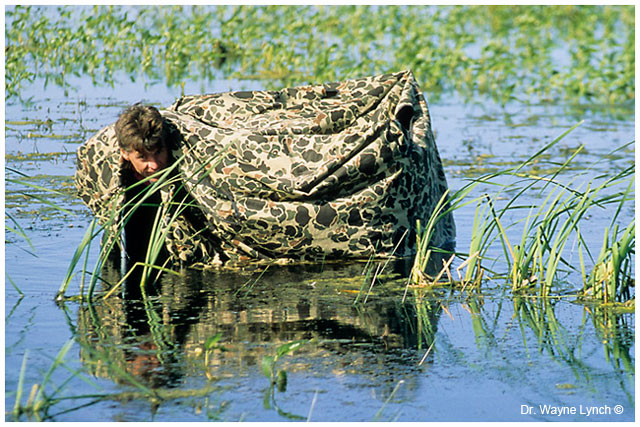
Wayne in a water blind
Why Use a Blind?
 The greatest benefit of squirreling yourself inside a cramped, often overheated, and sometimes mosquito-infested photo blind is that you get to observe, and hopefully photograph, a greater range of animal behavior than would usually be possible if you were standing out in the open. In my experience, natural behavior such as courtship, mating, grooming and predation rarely happen when a wild bird or animal is nervous and concentrating on a nearby Homo photographicus. Photo on the left - Eared Grebe. The greatest benefit of squirreling yourself inside a cramped, often overheated, and sometimes mosquito-infested photo blind is that you get to observe, and hopefully photograph, a greater range of animal behavior than would usually be possible if you were standing out in the open. In my experience, natural behavior such as courtship, mating, grooming and predation rarely happen when a wild bird or animal is nervous and concentrating on a nearby Homo photographicus. Photo on the left - Eared Grebe.
When To Use A Blind?
Blinds can be used in any season but naturally they are most helpful when there is some predictability to the movements of the local wildlife. In winter, I’ve set up different blinds beside ice-free areas of frozen lakes and rivers where bald eagles and mink were hunting and muskrats and waterfowl were feeding.
Winter is also a good season to take advantage of roadkills, of which there are millions annually. In such a situation you may attract a guild of scavengers from eagles, ravens and magpies to coyotes, wolves and bears, and the careful placement of a blind can yield exciting opportunities. Autumn and early spring are often good times to scope out locations for resting and foraging avian migrants such as swans, geese, ducks, sandhill cranes and shorebirds. Not surprisingly, the most productive seasons in which to use a blind are late spring and early summer when birds are hatching, young fox and coyote pups are playfully bouncing about and nature is in full renewal and replacement.
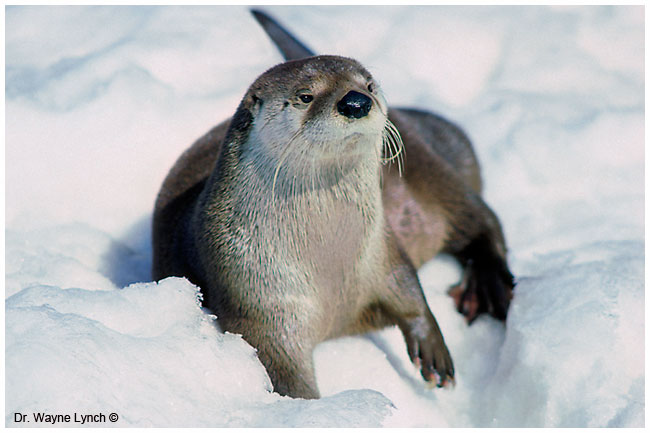
River Otter
So, if you haven’t made the plunge and spent time entombed inside a blind, do yourself a favour and give it a whirl. No matter what happens, it’s always an unpredictable adventure and sometimes an exhilarating rush.
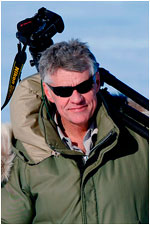
|
|
For several decades Dr. Wayne Lynch has been the most published wildlife photographer and nature writer in Canada. His credits include hundreds of magazines covers, thousands of calendar shots and tens of thousands of images published worldwide.
To see more of his work you can visit: www.waynelynch.ca |
|






 to season. Before I set up a blind I always scout the location beforehand to see how promising the site looks, how skittish the wildlife is, and whether my blind is likely to cause a disturbance. In these times of increasing human population and declining wilderness no photographer should place the pursuit of an image ahead of the welfare of the environment or the survival or well-being of a wild creature. For example, if your blind causes undue delay in the return of an incubating bird to its nest or alerts a predator or a mischievous human to the location of a nest or den then you should remove the blind immediately and search for safer location.
to season. Before I set up a blind I always scout the location beforehand to see how promising the site looks, how skittish the wildlife is, and whether my blind is likely to cause a disturbance. In these times of increasing human population and declining wilderness no photographer should place the pursuit of an image ahead of the welfare of the environment or the survival or well-being of a wild creature. For example, if your blind causes undue delay in the return of an incubating bird to its nest or alerts a predator or a mischievous human to the location of a nest or den then you should remove the blind immediately and search for safer location. 
 The greatest benefit of squirreling yourself inside a cramped, often overheated, and sometimes mosquito-infested photo blind is that you get to observe, and hopefully photograph, a greater range of animal behavior than would usually be possible if you were standing out in the open. In my experience, natural behavior such as courtship, mating, grooming and predation rarely happen when a wild bird or animal is nervous and concentrating on a nearby Homo photographicus. Photo on the left - Eared Grebe.
The greatest benefit of squirreling yourself inside a cramped, often overheated, and sometimes mosquito-infested photo blind is that you get to observe, and hopefully photograph, a greater range of animal behavior than would usually be possible if you were standing out in the open. In my experience, natural behavior such as courtship, mating, grooming and predation rarely happen when a wild bird or animal is nervous and concentrating on a nearby Homo photographicus. Photo on the left - Eared Grebe. 
